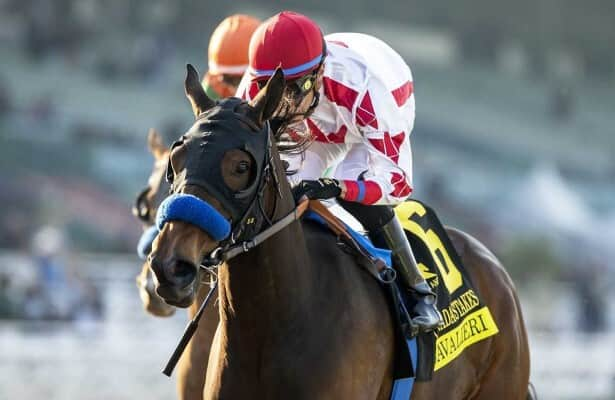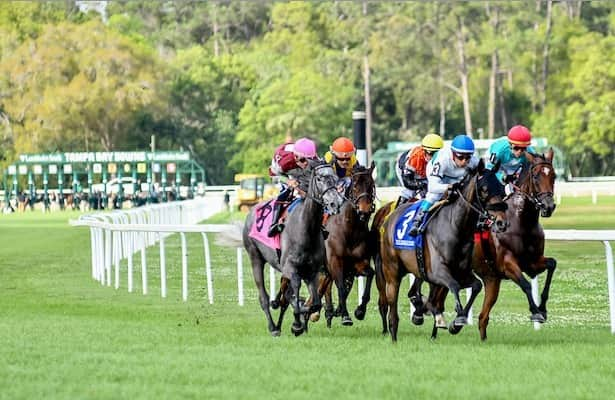Breeders’ Classic Winner Sierra Leone Will Continue Racing In 2025

DEL MAR, CALIFORNIA – NOVEMBER 02: Sierra Leone with Flavien Prat riding wins the Breeders Cup Classic on day two of the 2024 Breeders’ Cup World Championships at Del Mar Race Track on November 02, 2024 in Del Mar, California. (Photo by Horsephotos/Getty Images)
Getty Images
We can be forgiven for thinking that the Breeders’ Cup races, and particularly the big-boys’ Classic, are done and dusted. From the owners’ perspective, marquee races such as the Breeders’ can create — or diminish, as the Fates would have it — far greater ongoing value in the the athletes themselves. It’s not called the Breeders’ Cup for nothing — horses that win, and many who don’t, breed. The usual equation, and the metric that powers, and can truncate, many a racehorse’s career, is: Race till you win big, cash that victory or victories out in the breeding barn.
But as with every form of athletic endeavor, time is the bomb ticking over in the corner. The risk of injury for all high-performance athletes is high, none more so than equine athletes, and the performance metrics Thoroughbred racing are particularly unforgiving. Sometimes that string of big wins doesn’t come, or doesn’t come in time, which are just two of the available pitfalls in the attempt to preserve the evanescent value of talented runners by breeding them. Players bet on horses, and occasionally in a big, entertaining way, but owners and breeders bet on Thoroughbred bloodlines and foals in a whole different order of magnitude.
The current poster boy for this ongoing-value debate is Classic winner Sierra Leone, pictured above in the teeth of his huge stretch run past Fierceness on November 2. Obviously, Sierra Leone only added to his breeding-barn value by receiving a stratospheric 112 Beyer speed figure for the dominance of that glorious close, the highest speed figure earned by any horse racing in America that weekend. Sierra Leone’s was a stupendous performance, letter perfect, capping a remarkable third year of life for the colt, his second on the track.
But, in a racing time metric, that was eons back in the pre-November 2 geologic epoch, before the heart-stopping Breeders’ victory. This is now, and precisely now comes the complex aftermath of a 2024 such as this in the life of this colt. In a post on X from a group of his owners, Coolmore Stud, it was confirmed that the deep-closing champion will be spending his fourth year on the planet racing. Which was, for fans, players, track operators and the sport in general, splendid news. Sierra Leone will draw people to the track.
In a nutshell, the question of retirement from the track is only, ever, answered by the fact that nearly every horse of worth is certainly bred, but the question of when that retirement commences is nuanced, faced more or less universally by the owners of every great stakes champion. There’s no mystery here — Sierra Leone will be bred, many hundreds of times. It will make his team extremely wealthy.
If racing is about pedigree, which it is to an extent, worth a close look is what happened with Sierra Leone’s legendary daddy, Gun Runner, a relatively late bloomer. At four years old in 2017, Gun Runner manufactured his banner racing year by winning, in order, the Stephen Foster at Churchill Downs, both the Whitney and the Woodward at Saratoga, and the Breeders’ Cup Classic at Del Mar. Gun Runner’s track career concluded in January 2018 with, famously, his victory in the second-ever Pegasus at Gulfstream.
Today Gun Runner is the second-leading sire in America, commanding an eye-watering $250,000 per stand stud fee at Three Chimneys Farm in Kentucky. He has earned many millions in the stud barn since 2018, and his foals have gone on to earn many more millions on the track. Just one statistic out of his breeding career from 2022, when he was bred to 256 mares — the most of any stallion that year in America — will suffice: Seventy-five per cent of those unions resulted in 192 live foals. His stud fee in 2022 was half what it is today, $125,000 per stand. His many breeding contracts are not public, but between breeders and stallion owners there are many different ways to slice stud fees, given the high prices that top champions’ foals bring when sold. Since the first crops of Gun Runner’s foals, such as Sierra Leone, have turned in many championship performances, that drives their prices at Keeneland or Fasig-Tipton into the stratosphere, and those prices can be factored into stud fee contracts.
That noted, here’s Gun Runner’s base number: In straight stud fees, the math on those 192 Gun Runner foals in 2022 would be a very tidy $24 million (at $125,000 per). Obvious as it may be on paper, it’s worth reminding ourselves that that sum, give or take, is just the take from one year. Now his stud fees are twice what they were in 2022, which is to say, if as it seems Gun Runner’s approximating his 2022 datebook in 2024, it’s $48 million, give or take. Worth hanging around for, if you happen to be among the fortunate few to have staked him from the get-go.
Understandably, numbers like these beckon heavily to owners as they make the decision to keep a horse like Sierra Leone on the track over the winter following his big last full year of racing.
There are two main differences between Sierra Leone and his father in making the transition between the track and the breeding barn. Gun Runner and his connections were back in 2018 fortunate that the Stronachs were in the business of establishing the Pegasus as an annual fixture on the calendar, thus, the total purse for the Pegasus was a gargantuan $16 million — as compared to now, when the race offers a more modest, but still welcome, $2 million. Gun Runner took home the winner’s cut of $7 million that year. Any way you look at it, for two-minutes’ fine work over a mile-and-an-eighth, it was a kick of a payday.
Second: Gun Runner’s additional, arguably greater, stroke of luck was that the Stronachs decided to seat their new race in the traditional hole in the racing calendar, at the end of January, which meant that he could make a blazing strike on the Pegasus and would not necessarily miss out on the 2018 breeding season, which in Lexington kicks off in February and runs through June. Long story short, the tactic worked. He hit the big Pegasus payday and immediately retired to the barn.
Although it seems from the tone of the news drop that his owners are thinking to keep Sierra Leone on the track for more of 2025 past January in Hallandale, the heralded son is now in a position to do just what his father did. This year he’s put together a similar banner year to that of his sire in 2017-8. Although the total purse for the 2025 Pegasus on January 25 will be slightly less than half what Sierra Leone’s father took home, it will remain the marquee it has become, and as a prep for the Saudi and Dubai cups later in the winter, it beckons mightily.
Bluntly put, it’s inevitable Sierra Leone will retire to braid his fine late-closing racing DNA back into the sport. But for the moment, anyway, his owners have decided that he should stay battle-ready.
Related
Leading Parx jockey Sanchez will serve 7-day suspension
Photo: Jason Moran / Eclipse Sportswire Jockey Mychel Sanchez will serve a seven-day suspension and pay an additional $1,750 in fines
Bill Mott talks about plans for Sovereignty, Just F Y…
Photo: Gulfstream Park / Lauren King Sovereignty, dramatic late-running winner of the Fountain of Youth (G2) March 1, is being pointed
Up-and-coming Cavalieri chases Grade 1 glory in Beholder Mile
Photo: Santa Anita / Benoit Photo Cavalieri and Alpha Bella, who finished one-two in the Grade 3 La Cañada in January at Santa Anita,
4 stakes showcase shipping stars on Tampa Bay undercard
Photo: Gonzalo Anteliz Jr. / Eclipse Sportswire The stars will shine Saturday at Tampa Bay Downs, and not just in the Grade 3 Tampa Ba











